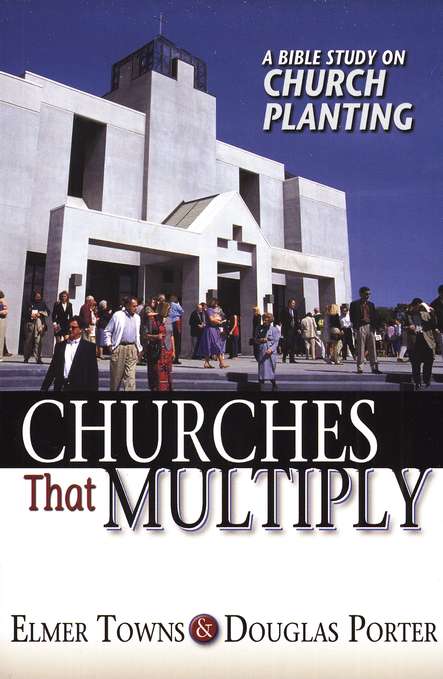
Churches That Multiply by Elmer Towns and Douglas Porter
Churches That Multiply by Elmer Towns and Douglas Porter is an excellent Bible study for a group to go through before starting a church. Twelve lessons deal with various facets of planting churches. Each short chapter ends with (1) personal lessons to take away, (2) church lessons to take away, (3) personal projects and (4) church projects. The lessons start with the post-resurrection ministry of Jesus, and proceed through the New Testament. Practical lessons and principles are taken from Jesus, His disciples, as well as the churches of Jerusalem, Samaria, Caesarea, Antioch, Galatia, Philippi, Thessalonica, Berea, Athens, Corinth and Ephesus.
The book is a training Bible study in the classic style of the Church Growth Movement. As a result, the book covers subjects such as strategic planning, witnessing, saturation evangelism, lay ministry, crossing cultural barriers, faithfulness during problems, relationship ministry, felt-needs ministry, ministry grounded in the Bible, understanding the culture, spiritual gifts in ministry and leadership training. The books assumes that principles and action steps can be found by looking at the way the early church.
Towns and Porter share many insights from the study. They begin with an analysis of the Great Commission, which is listed five times in the New Testament (John 20:21, Mark 16:15, Matthew 28:19-20, Luke 24:46-48, Acts 1:8). They suggest that the primary message to share in the new church plant is the Gospel. Towns and Porter emphasize that the church planter should spend time sharing the Gospel (17). This reviewer would agree that the primary message which should be preached is the Gospel. The church planter should return to that message in every message and as a theme every year. However, the church does need to hear from the entire Word of God, not just the Great Commission passages.
Towns defines as evangelism (27) as “communicating the gospel in an understandable manner and motivating the person to receive Christ and become a responsible member of His Church.” While evangelism does involve preaching the gospel, witnessing is a form of evangelism. A witness is someone who points another person to the gospel. The authors make a clear distinction between an evangelist and a witness (28). The authors share ideas with which many people can be witnesses. They stress that not every person is an evangelist, but everyone is expected to be a witness (Acts 1:8). This insight can be helpful in teaching people how to reach out to their community. The fear of “being an evangelist” (primarily because of the itinerant evangelist ministry) prevents many Christians from desiring to be a good witness. This books helps overcome that barrier. This reviewer appreciated the effort Towns and Porter took to highlight the ministry of the Holy Spirit in church planting (34-35). Many books miss this ministry in the work of church planting. Specifically, many Southern Baptist churches could learn much from this teaching in the book.
The authors spend time to describe the nature of revival. Their definition (“God pouring out His presence on His people”) is simple and God-centered (42). Church plants should experience revival as part of its birthing process. Revival can also come to the partnering churches as a result of this emphasis on “making disciples.” The authors emphasize that since the Jerusalem church spent time in “saturation evangelism” – preaching the gospel constantly to everyone and in every place possible, the revival and growth came as a natural result. Personally, this author knows that God gave the increase, and it seems difficult to accept this saturation evangelism was the only reason for this outpouring of salvation (50). Another author contends that the Jerusalem church multiplied in spite of the reluctance of the apostles to reach out to the surrounding towns (see How to Multiply Your Church pages 123-125). However, God did allow a multiplication effect in the Jerusalem church. God sometimes works through us despite our inaction.
Prayer is essential in the work of the church, especially church multiplication. Towns and Porter describe seven ways in which an effective prayer life can be undermined. When Christians turn inward, their prayer life diminishes and the work of the Gospel in the church is hindered. The church plant should keep prayer in the forefront of the work (100-101). However, using classic Church Growth theory, the authors describe the elimination of barriers as the key to effectiveness (128-130). The pages spent on the nature of witnessing, building relationships, saturation evangelism, and overcoming barriers makes one believe that man’s effort is more important than prayer. Perhaps prayer is assumed as necessary in the minds of the authors.
Overall, the short book followed the New Testament as the model and basis for church planting. The work is grounded in the Great Commission and many examples from the New Testament churches are used to illustrate the principles involved. Although this reviewer takes exception to the authors bias toward church growth theory as the most effective form of church planting practice, the principles are solid. The book was heavy on methods and steps and less on spiritual formation. The book complements many other books in the Church Growth Movement, notably Purpose Driven Church by Rick Warren, Launch by Nelson Searcy and Kerrick Thomas and Starting a New Church by Ralph Moore. This is a book that gives a good survey of church planting in the New Testament as well as projects to coincide with the study. This book would work well as a Bible study for a group of people coming together to start a church as the initial Bible study.












